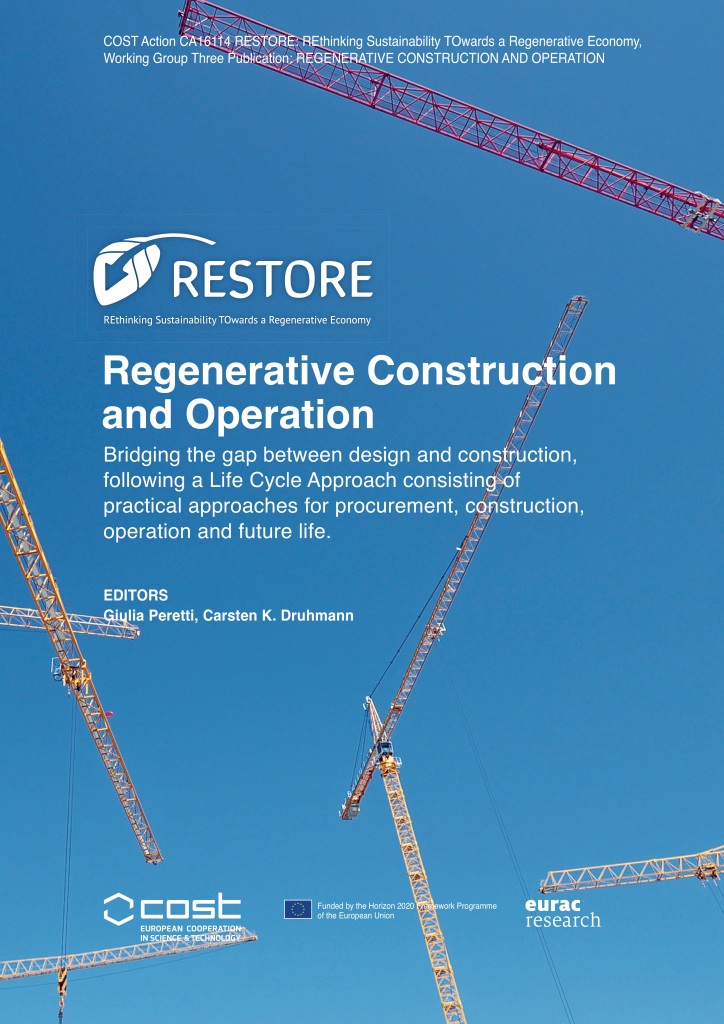
The transition to a Regenerative Economy is about seeing the world in a different way: a shift to an ecological world view in which nature is the model.
The third publication in the ‘Regenerative Sustainability series from COST Restore is now available (free download from the CostRestore webpages)
Design can no longer be only concerned with reducing environmental impacts within the threshold of greenhouse gas emissions. Buildings today must be developed to reverse the effects of climate change, enhance natural systems, the built environment and habitants health.
“Regenerative Design in the Digital Practice” explores how the regenerative concept is now being applied to the regenerative design of cities and buildings. A series of digital design approaches are exemplified via a series of examples drawn from leading international practitioners and researchers.
This inspiring and comprehensive publication, stretching to over 400 pages is a huge achievement by editors Emanuele Naboni and Lisanne Havinga,working with Co-Editors: Martin Brown, Dr.Angela Loder, Sergio Altomonte, Terri Peters, Luca Finocchiaro, Ata Chokhachian, Clarice Bleil de Souza, Catherine De Wolf and Antonino Marvuglia it contains over 100 contributors.
“Regenerative Design in the Digital Practice” fills a gap in the existing literature by introducing fundamental design principles of regenerative design practice whilst acknowledging the potential and imperative of integrating science, big data and multi-discipline digital tools in the design process.
This book offers those involved within the built environment a wide range of insights into regenerative design from international design practitioners and researchers in the field. As well as theoretical insights into the historical, cultural and philosophical development of regenerative design, practical insights are framed in a set of key regenerative design principles, methods and performance simulation tools. Finally, the ability to create regenerative designs and the positive impacts they bring are demonstrated through a series of built examples.

CONTENTS:
REGENERATIVE DEFINITIONS FOR DESIGNERS
The Pillars of Regenerative Design
Edited Martin Brown, Emanuele Naboni, Lisanne Havinga
TOOLS AND DATA FOR HOLISTIC MODELLING
Simulating Regenerative Futures
Edited Emanuele Naboni, Clarice Bleil de Souza, Terri Peters, Lisanne Havinga
CLIMATE AND ENERGY FOR REGENERATIVE URBAN DESIGN
Local Context, Adaptation, Resilience
Edited Emanuele Naboni, Ata Chokhachian, Luca Finnochiaro, Lisanne Havinga
CARBON AND ECOLOGY WITHIN THE DESIGN PROCESS
Environmental Impact Assessment
Edited Lisanne Havinga, Catherine De Wolf, Antonino Marvuglia, Emanuele Naboni
HUMAN WELL-BEING VIA CERTIFICATION AND TOOLS
Comfort, Health, Satisfaction, Well-being
Edited Angela Loder, Sergio Altomonte, Emanuele Naboni, Lisanne Havinga
CASE STUDIES SHOWCASING REGENERATIVE DESIGN 346
From Theory to Realisation
Edited by Emanuele Naboni, Lisanne Having
The other COST Restore Publications, also free to download, include:
Sustainability, Restorative to Regenerative

An exploration in progressing a paradigm shift in built environment thinking, from sustainability to restorative sustainability and on to regenerative sustainability.
Regenerative Construction and Operation

Bridging the gap between design and construction, following a Life Cycle Approach consisting of practical approaches for procurement, construction, operation and future life.
Future titles will include Regenerative Technologies, Scale Jumping and Atlas of Solutions.
